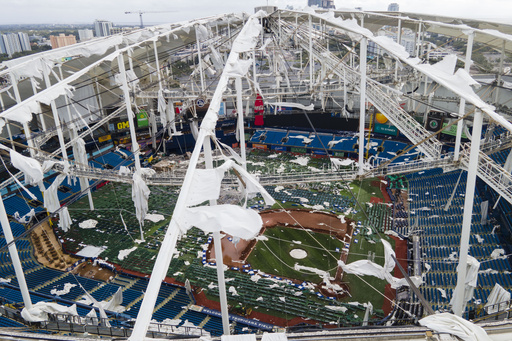
ST. PETERSBURG, Fla. — A comprehensive evaluation of the damage inflicted by Hurricane Milton on Tropicana Field has determined that the Tampa Bay Rays’ home is structurally intact and can be repaired at an estimated cost of $55.7 million, with repairs expected to be completed in time for the 2026 season.
The City of St. Petersburg, the owner of the stadium, published a 412-page report on Tuesday revealing that the essential framework of the domed venue “does not appear to have been adversely affected” by the hurricane’s strong winds, which caused significant damage to the stadium’s fabric roofing.
The report, compiled by Hennessy Construction Services, noted that although 18 out of the 24 fabric panels were destroyed during the storm, the main structure remains functional and is suitable for supporting a new tension membrane fabric roof.
The storm, which made landfall on October 9, also caused interior damage due to rainwater and other storm-related factors. Tropicana Field, which opened its doors in 1990, has served as the Rays’ home since the team debuted in 1998.
Plans are already in place for the demolition of Tropicana Field following the completion of a new $1.3 billion ballpark, scheduled for the 2028 season. Unforeseen expenses stemming from Hurricane Milton, along with issues from other recent hurricanes, have raised concerns regarding the funding for both projects. Potential revenue streams for the new ballpark might be reconsidered or may lead to the decision to abandon repairs on Tropicana Field completely.
The findings from the report will be discussed at the St. Petersburg City Council meeting set for November 21. Council member Brandi Gabbard emphasized the challenging decision-making process: “We have so much need across the city. I love the Rays. I love Tropicana Field. It’s not about not wanting to do this. It’s about a balance of priorities.”
In the meantime, the council sanctioned $6.5 million for immediate cleanup efforts at the ballpark and to shield it from further damage, including waterproofing crucial areas such as the press box, seating, and scoreboard.
Although there is an insurance claim in place to cover damage and repairs, it carries a hefty $22 million deductible and is expected to only partially address the total repair costs, meaning taxpayer funds will likely be necessary.
The Rays did not provide an immediate response regarding the assessment on Tuesday. Since repairs to the ballpark would not conclude until 2026, the team will need to identify an alternate venue for the upcoming season.
Major League Baseball is encouraging the Rays to stay within their fanbase’s region, and several nearby spring training locations have been suggested. These include facilities in Clearwater (Phillies), Tampa (Yankees), Dunedin (Blue Jays), Sarasota (Orioles), Lakeland (Tigers), and their own spring training site in Port Charlotte, most of which also accommodate minor league teams during the summer months.
The planned new ballpark for the Rays is part of an extensive $6.5 billion development project, which aims to introduce affordable housing, a Black history museum, and spaces for retail, offices, restaurants, and bars. This project, known as the Historic Gas Plant District, aims to revitalize an area that once flourished as a Black community but was displaced by the stadium construction and surrounding infrastructure.
